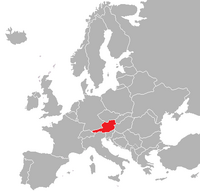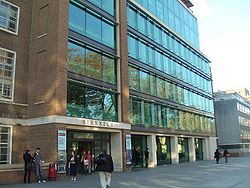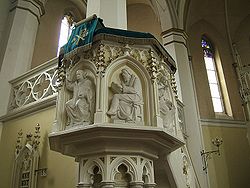Difference between revisions of "Religion and migration"
Conservative (Talk | contribs) (→Religious immigrants to Europe resistant to secularization) |
Conservative (Talk | contribs) (→Religious immigrants to Europe resistant to secularization) |
||
| Line 45: | Line 45: | ||
See also: [[Growth of religious fundamentalism]] | See also: [[Growth of religious fundamentalism]] | ||
| + | == United States, immigration and the growth of religion in the USA in the latter part of the 21st century == | ||
| + | |||
| + | See also: [[United States, immigration and the growth of religion in the USA in the latter part of the 21st century]] | ||
| + | |||
== Religious immigrants to Europe resistant to secularization == | == Religious immigrants to Europe resistant to secularization == | ||
[[File:800px-Mikolow protestant church pulpit.jpg|thumbnail|250px|right|Conservative [[Protestantism|Protestants]] have relatively high fertility rates.<ref>[http://questionevolution.blogspot.com/2012/08/immigrants-become-more-religious-longer.html Religious immigrants will alter the religious landscape of Europe]</ref> (Picture: Protestant church pulpit in Europe) ]] | [[File:800px-Mikolow protestant church pulpit.jpg|thumbnail|250px|right|Conservative [[Protestantism|Protestants]] have relatively high fertility rates.<ref>[http://questionevolution.blogspot.com/2012/08/immigrants-become-more-religious-longer.html Religious immigrants will alter the religious landscape of Europe]</ref> (Picture: Protestant church pulpit in Europe) ]] | ||
Revision as of 14:42, May 4, 2024

According the Futures Centre:
| “ | Human migration between and within countries is increasing as a result of global economic ties, improving global communications, increasing mobility and government policy (particularly in the case of the EU).
The number of international migrants is rising – their number increased by over 77 million (50%) between 1990 and 2013. A total of 69% migrants moved to a developed country, and 31% to a developing one. Around 25 million migrated to North America. In 2013, ‘South-North migration’ – i.e. the number of international migrants born in the South who live in the North – almost equalled the number of migrants born in the South who live in the South, or ‘South-South migration’.[2] |
” |
As far as the Global South, in 2011, the American Spectator declared that charismatic Christianity is "exploding" in the Global South in terms of its growth.[3]
Contents
- 1 Religious people are more likely to immigrate. Christian/Muslim immigration
- 2 Eric Kaufmann on the future of religious immigration
- 3 United States, immigration and the growth of religion in the USA in the latter part of the 21st century
- 4 Religious immigrants to Europe resistant to secularization
- 5 See also
- 6 Notes
Religious people are more likely to immigrate. Christian/Muslim immigration
According to British author Edward Dutton, religious people are more likely to migrate (there are various reasons postulated, but it remains unclear why this is so).[4]
According to Dutton, this partly explains why the British people who left Britain and migrated to America in the colonial period were more religious.[5]
Currently, there are many evangelical Christians and Muslims moving to secular regions (See: Growth of evangelical Christianity in irreligious regions).
According to Pew Forum:
| “ | About 3% of the world’s population has migrated across international borders. While that may seem like a small percentage, it represents a lot of people. If the world’s 214 million international migrants were counted as one nation, they would constitute the fifth most populous country on the globe, just behind Indonesia and ahead of Brazil.
Faith on the Move, a new study by the Pew Research Center’s Forum on Religion & Public Life, focuses on the religious affiliation of international migrants, examining patterns of migration among seven major groups: Christians, Muslims, Hindus, Buddhists, Jews, adherents of other religions and the religiously unaffiliated. Christians comprise nearly half – an estimated 106 million, or 49% – of the world’s 214 million international migrants, the total number of people who reside permanently in a country other than where they were born. (See Defining International Migrants box. All figures in this report are as of 2010.) Muslims make up the second-largest share of people who have migrated across borders – almost 60 million, or 27% Hindus (nearly 11 million) account for 5%) and Buddhists (about 7 million) account for 3%.[6] |
” |
Eric Kaufmann on the future of religious immigration

Professor Eric Kaufmann, who teaches at Birkbeck College, University of London, specializes in the academic area of how demographic changes affect religion/irreligion and politics. Kaufmann is an agnostic.
On December 23, 2012, Kaufmann wrote:
| “ | I argue that 97% of the world's population growth is taking place in the developing world, where 95% of people are religious.
On the other hand, the secular West and East Asia has very low fertility and a rapidly aging population... In the coming decades, the developed world's demand for workers to pay its pensions and work in its service sector will soar alongside the booming supply of young people in the third world. Ergo, we can expect significant immigration to the secular West which will import religious revival on the back of ethnic change. In addition, those with religious beliefs tend to have higher birth rates than the secular population, with fundamentalists having far larger families. The epicentre of these trends will be in immigration gateway cities like New York (a third white), Amsterdam (half Dutch), Los Angeles (28% white), and London, 45% white British.[11] [12] |
” |
At a conference Kaufmann said of religious demographic projections concerning the 21st century:
| “ | Part of the reason I think demography is very important, at least if we are going to speak about the future, is that it is the most predictable of the social sciences.
...if you look at a population and its age structure now. You can tell a lot about the future. ...So by looking at the relative age structure of different populations you can already say a lot about the future... ...Religious fundamentalism is going to be on the increase in the future and not just out there in the developing world..., but in the developed world as well.[13] |
” |
See also: Growth of religious fundamentalism
United States, immigration and the growth of religion in the USA in the latter part of the 21st century
Religious immigrants to Europe resistant to secularization

See also: Religious immigrants to Europe resistant to secularization and Desecularization and Growth of global desecularization
In 2019, The Annual Review of Sociologypublished a journal article entitled Assimilation and the Second Generation in Europe and America: Blending and Segregating Social, Dynamics between Immigrants and Natives which indicated:
| “ | The persistence of a strong religious culture among Muslim immigrants long after having migrated and among the second generation is remarkable given the normative pressure toward secularism and lower religiosity levels in the European context. In Britain, Muslims’ religious identity is demonstrably as salient among individuals who migrated fifty years ago as among those who were born in the United Kingdom (Bisin et al. 2008, Lewis & Kashyap 2013).[15] | ” |
In 2011, a paper was published entitled The End of Secularization in Europe?: A Socio-Demographic Perspective. The authors of the paper were: Eric Kaufmann - Birkbeck College, University of London; Anne Goujon - World Population Program, International Institute for Applied Systems Analysis (IIASA); Vegard Skirbekk World Population Program, International Institute for Applied Systems Analysis (IIASA).[16]
An excerpt from the paper by Kaufmann, Goujon and Skirbekk:
| “ | Conservative Protestants, a much larger group than the Mormons, also benefit from relatively high fertility. Hout et al. (2001) find that three-quarters of the growth of conservative Protestant denominations against their liberal counterparts is due to fertility advantage rather than conversion.
In Europe, there has been less attention paid to fertility differences between denominations. However, several studies have discovered that immigrants to Europe tend to be more religious than the host population and — especially if Muslim—tend to retain their religiosity (Van Tubergen 2006). Though some indicators point to modest religious decline toward the host society mean, other trends suggest that immigrants become more, rather than less, religious the longer they reside in the host society (Van Tubergen 2007). All of which indicates that religious decline may fail at the aggregate level even if it is occurring at the individual level (Kaufmann 2006, 2010). This article thereby investigates the hypothesis that a combination of higher religious fertility, immigration, and slowing rates of religious apostasy will eventually produce a reversal in the decline of the religious population of Western Europe.[17] |
” |
Research indicates that among ethnic minority immigrants religion is a source of group ethnic identification which makes them more resistant to secularization.[18] In most countries, with the exception of France, Muslim immigrants have nearly 100% retention rates for the second generation.[19]
Islamic creationism and resistance to assimilation
In recent years Britain, the birthplace of Darwinism, has seen a large influx of Muslim immigrants. Most religious Muslims are creationists.[20] In the UK, between the years 2001 and 2009 the Muslim population increased nearly 10 times faster than the non-Muslim population.[21] See also: Islam and belief in creationism
The British newspaper The Telegraph reported in an article entitled Richard Dawkins: Muslim parents 'import creationism' into schools:
| “ | Prof Dawkins, a well-known atheist, also blamed the Government for accommodating religious views and allowing creationism to be taught in schools.
"Most devout Muslims are creationists so when you go to schools, there are a large number of children of Islamic parents who trot out what they have been taught," Prof Dawkins said in a Sunday newspaper interview. "Teachers are bending over backwards to respect home prejudices that children have been brought up with. The Government could do more, but it doesn't want to because it is fanatical about multiculturalism and the need to respect the different traditions from which these children come."[22] |
” |
See also
- Causes of desecularization
- European desecularization in the 21st century
- Desecularization and aging populations
Notes
- ↑ Shall the Religious Inherit the Earth?: Demography and Politics in the Twenty-First Century by Eric Kaufmann
- ↑ Migration
- ↑ Thriving Christianity
- ↑ Why Are Americans So Religious?
- ↑ Why Are Americans So Religious?
- ↑ Faith on the Move – The Religious Affiliation of International Migrants, Pew Forum
- ↑ Shall the Religious Inherit the Earth?: Demography and Politics in the Twenty-First Century by Eric Kaufmann, Belfer Center, Harvard University/Birkbeck College, University of London
- ↑ Eric Kaufmann: Shall The Religious Inherit The Earth?
- ↑ Eric Kaufmann's Atheist Demographic series
- ↑ Eric Kaufmann: Shall the Religious Inherit the Earth?, Australian Broadcasting Corporation
- ↑ London: A Rising Island of Religion in a Secular Sea by Eric Kaufmann, Huffington Post, 2012
- ↑ 97% of the world's population growth is taking place in the developing world, where 95% of people are religious, Tuesday, April 30, 2013
- ↑ Eric Kaufmann - Religion, Demography and Politics in the 21st Century
- ↑ Religious immigrants will alter the religious landscape of Europe
- ↑ Assimilation and the Second Generation in Europe and America: Blending and Segregating Social, Dynamics between Immigrants and Natives, The Annual Review of Sociology by Lucas G. Drouhot and Victor Nee, 2019. 45:X–X, https://doi.org/10.1146/annurev-soc-073117-041335
- ↑ Religious immigrants will alter the religious landscape of Europe
- ↑ Religious immigrants will alter the religious landscape of Europe
- ↑ Eric Kaufmann - Religion, Demography and Politics in the 21st Century
- ↑ Eric Kaufmann - Religion, Demography and Politics in the 21st Century
- ↑ Hameed S (2008). "Bracing for Islamic creationism". Science 322 (5908): 1637–8.
- ↑ Muslim population 'rising 10 times faster than rest of society' 30 January 2009, Richard Kerbaj, The Sunday Times
- ↑ Richard Dawkins: Muslim parents 'import creationism' into schools, The Telegraph